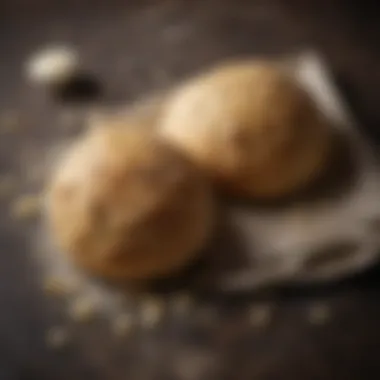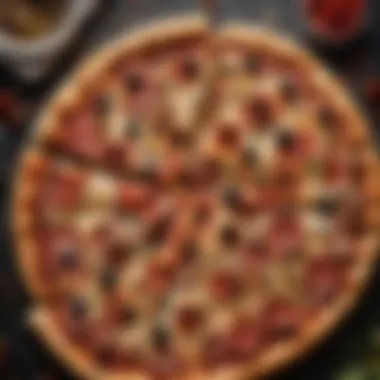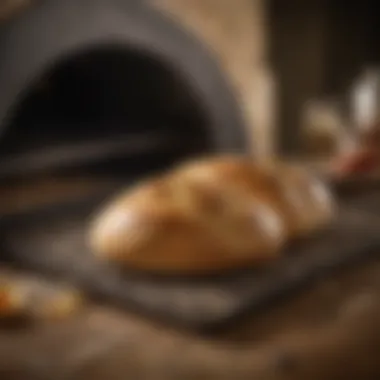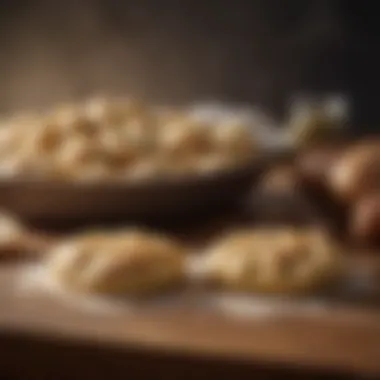Mastering WW Two Ingredient Dough for Pizza Lovers


Pizza Recipe Foreword
The world of pizza is vast and full of potential, especially when exploring the WW two ingredient dough. This culinary creation simplifies the process of pizza making, allowing both novices and seasoned cooks to craft delightful pizzas with minimal effort. The versatility of this dough extends beyond just pizza; it opens doors to a variety of baked goods.
The key ingredients in WW two ingredient dough are self-rising flour and Greek yogurt. These components not only provide the necessary structure for the dough but also enhance its nutritional profile, making it a clever choice for health-conscious foodies. This straightforward recipe invites creativity, influenced by different cultures and flavors, making it adaptable to various tastes and preferences.
Ingredients and Preparation
Ingredients
- Self-Rising Flour: Provides consistency and rise to the dough.
- Greek Yogurt: Acts as a binding agent and adds moisture and protein.
- Optional Seasonings: Garlic powder, oregano, salt, and pepper to taste.
Preparation Steps
- Combine Ingredients: In a bowl, mix one cup of self-rising flour with one cup of Greek yogurt. Combine until a shaggy dough forms.
- Knead the Dough: Turn the dough onto a lightly floured surface. Knead gently for about 5 minutes until smooth.
- Rest the Dough: Allow the dough to rest for 10 minutes. This enhances elasticity.
- Roll Out: Roll the dough to your desired thickness, depending on how thick or thin you prefer your crust.
Tips for Handling Ingredients
- Ensure the Greek yogurt is not too runny; this helps maintain the proper dough consistency.
- Use additional flour sparingly to avoid a dry dough.
Assembly and Baking
Assembling the Pizza
- Spread Sauce: Use a prepared tomato sauce or create your own by blending tomatoes with herbs.
- Add Cheese: Sprinkle a generous amount of shredded mozzarella or your preferred cheese.
- Toppings: Add vegetables, meats, or any other toppings to taste.
Baking Instructions
- Preheat the oven to 475°F (245°C).
- Bake for approximately 12-15 minutes or until the crust is golden brown and cheese is bubbly.
Variations and Customization
- Experiment with different flours like whole wheat or gluten-free options.
- Add spices directly into the dough for enhanced flavor.
Serving Suggestions and Pairings
To elevate the pizza experience, consider these serving suggestions:
- Garnish the pizza with fresh basil or a drizzle of olive oil.
- Serve with a side of mixed greens dressed lightly with vinaigrette.
Beverage Pairings
- A crisp white wine like Sauvignon Blanc
- Craft beers with a hoppy profile, complementing savory toppings.
Cook's Notes and Tips
- Flavor Enhancement: Brush the crust edges with garlic butter before baking for a richer taste.
- Troubleshooting: If the dough is too sticky, add a bit more flour; if too dry, incorporate a small amount of yogurt.
The WW two ingredient dough is more than just a quick fix; it’s a pathway to pizza creativity and enjoyment. Embrace its adaptability to enhance your culinary journey.
Prelims to WW Two Ingredient Dough
The concept of WW two ingredient dough stands as a noteworthy advancement in modern cooking, particularly among those who appreciate the simplicity and flexibility in their culinary creations. This dough, made from just two primary ingredients, offers a range of possibilities that appeal to both seasoned chefs and home cooks. Its relevance in contemporary food culture is undeniable as it caters to various dietary preferences and lifestyle choices. In this article, we explore its core components, preparation techniques, and numerous applications.
What is WW Two Ingredient Dough?
WW two ingredient dough, commonly referred to as a versatile and simple dough, primarily consists of self-rising flour and Greek yogurt. This combination yields a dough that can be transformed into a myriad of dishes, from pizzas to calzones and beyond. The simplicity of the ingredients belies the many uses this dough can accommodate.
The self-rising flour adds a leavening agent, while the Greek yogurt contributes moisture and richness. The result is a dough that is both manageable and adaptable. It does not require additional yeast or extensive fermentation, making it a practical choice for quick meals. The ease of preparation allows individuals to experiment and create personalized dishes without excessive time investment.
Historical Context and Evolution


The evolution of WW two ingredient dough can be traced back to a desire for simplification in the cooking process. In recent years, home cooking has experienced a resurgence, with many people gravitating toward easier and faster recipes. The popularity of Greek yogurt and its integration into various dishes facilitated the development of this unique dough.
During this period, social media platforms played a significant role in promoting culinary trends. Creative food bloggers and cooking enthusiasts began to share their experiences with this two-ingredient mixture. The dough quickly gained traction not only in home kitchens but also within culinary circles as a viable alternative to more labor-intensive options. Over time, the adaptability of WW two ingredient dough has led to its acceptance across a variety of cuisines, making it a staple for many looking to explore new culinary horizons.
Key Ingredients of WW Two Ingredient Dough
The two main components of WW two ingredient dough are flour and yogurt. Understanding these key ingredients is essential for anyone looking to make effective use of this versatile dough. Each ingredient contributes not only to the texture and flavor but also to the nutritional profile of the final product. This section will give a detailed look into these ingredients to highlight their relevance and application in creating delicious pizza.
Understanding the Core Ingredients
Flour Variations
Flour type is a foundational aspect of WW two ingredient dough. Common choices include all-purpose flour, whole wheat flour, and even gluten-free options. All-purpose flour is a popular choice due to its accessibility and balance in texture. Whole wheat flour adds nutritional value, providing more fiber and minerals. However, it can make the dough denser, which might not suit everyone's preference.
A unique feature of flour variations is the protein content. Higher protein flours, like bread flour, yield a chewier crust. This characteristic helps in achieving different textures in end products, from soft to more substantial crusts. Choosing the right flour is crucial because it determines the mouthfeel of the finished pizza.
Yogurt Types
Choosing the correct type of yogurt equally impacts dough quality. Common options include Greek yogurt and plain yogurt. Greek yogurt is thicker and often contains higher protein levels, adding to the chewiness of the dough. On the other hand, plain yogurt is lighter, making it suitable for a softer dough.
The main advantage of using yogurt lies in its fermentation process. This fermentation produces lactic acid, contributing to flavor complexity and improved digestibility. Yogurt offers a unique feature of introducing probiotics, promoting gut health. Considering the yogurt type allows for personalization of the dough, depending on dietary needs and taste preferences.
Nutritional Information
Caloric Content
When assessing caloric content, WW two ingredient dough is relatively low in calories compared to traditional pizza crusts. Each serving provides a satisfying meal option without excessive calories. The lower caloric value makes it a beneficial choice for those monitoring their diet.
The caloric content in this dough varies based on the type of flour and yogurt used. Whole wheat flour typically adds more calories compared to all-purpose due to its denser composition. However, the trade-off is in the nutritional benefits that whole wheat provides.
Nutrient Breakdown
Nutrient breakdown reveals that this dough is rich in carbohydrates. However, crucially, it also boasts protein from the yogurt, particularly if Greek yogurt is used. This balance makes it a popular choice for those seeking a quick meal that fills nutritional requirements without being too heavy.
Some important nutrients to note include:
- Fiber: Present in whole wheat options, aiding digestion.
- Calcium: Derived from yogurt, beneficial for bone health.
- B Vitamins: Essential for energy metabolism, found in both flour alternatives.
While the two ingredient dough is not complete in nutrition alone, it serves as a formidable base for nutritious toppings to round out a meal.
Preparation Techniques for WW Two Ingredient Dough
The importance of preparation techniques in the context of WW two ingredient dough cannot be overstated. Proper preparation not only determines the texture and flavor but also affects how the dough can be used in various applications. Mastering these techniques enables the home cook to fully exploit the versatility of the dough, transforming simple ingredients into a delightful range of culinary creations. Moreover, learning how to effectively mix and knead the dough ensures a consistent outcome, minimizing the risk of undesired results during cooking.
Step-by-Step Preparation Guide
Mixing Techniques
Mixing techniques play a critical role in creating a well-integrated dough. The primary goal here is to achieve a uniform blend of flour and yogurt, ensuring that no dry spots remain. A key characteristic of effective mixing is the equal distribution of moisture throughout the flour. This is beneficial because it promotes an even consistency which is essential for achieving the desired dough texture.
When mixing, it is crucial to avoid overworking the dough. Overmixing can lead to tough dough, which is not ideal for recipes requiring a light and airy base. A unique feature of mixing techniques in this context is their simplicity; too much effort is unnecessary. Just a few gentle stirs usually suffice. The advantages include ease and speed; even novice cooks can produce acceptable results with minimal experience.
Kneading Process
Following the mixing, the kneading process is where the dough truly starts to develop its structure. Kneading is essential because it helps to activate the gluten present in the flour, providing the dough with the necessary elasticity. A notable characteristic of kneading is that it can vary in duration depending on personal preference and desired outcomes. Generally, about five to ten minutes of gentle kneading is suitable when making WW two ingredient dough.
This process is favored because it enhances the final product's chewiness, which is often sought after in pizza crusts. A unique advantage of kneading is that it empowers the cook to personalize the texture of the dough. However, one must be cautious, as excessive kneading may lead to dough that is overly tough and less enjoyable.
Common Mistakes to Avoid
In the journey of creating WW two ingredient dough, awareness of common mistakes can make a significant difference. Some common issues include:


- Not Measuring Ingredients Accurately: Precision is key in baking; even small deviations can affect the outcome.
- Overworking the Dough: As highlighted, both mixing and kneading should be approached with care to avoid toughness.
- Ignoring Dough Texture: Understanding the desired consistency prevents disappointment, as dough can appear overly dry or too wet without attention.
By paying attention to these aspects, cooks can enhance their experience with WW two ingredient dough, leading to delightful and successful culinary results.
Applications in Pizza Making
The applications of WW two ingredient dough in pizza making are significant. This dough fundamentally redefines the traditional approach to pizza, focusing on simplicity and versatility. For a broad range of culinary enthusiasts, both experienced cooks and novices, the adaptability of this dough fosters creativity. The dough’s basic structure allows for numerous interpretations, providing opportunities for innovation in flavor and texture.
Using WW two ingredient dough for pizza making offers compelling benefits such as time efficiency and ease of preparation. Users can create a delicious base with minimal effort, which can be particularly advantageous for busy lifestyles. Additionally, it allows for customization, meeting various dietary needs and preferences.
Classic Pizza Recipes Using WW Dough
Margherita Style
Margherita style pizza represents a classic choice within the realm of pizza creations using WW two ingredient dough. This is appreciated for its simplicity and emphasis on fresh ingredients. The key characteristics of Margherita style pizza are its milder flavors, featuring fresh basil, tomatoes, and mozzarella. This combination not only delivers taste but also is visually appealing, showcasing the vibrant colors of the ingredients.
The unique feature of Margherita pizza lies in its clean flavor profile, making it a beneficial choice for those wanting to enjoy the essence of the dough without overwhelming flavors. However, its simplicity may not appeal to those who prefer bolder tastes, showing a disadvantage in wider cravings for intense flavoring.
Pepperoni Delight
Pepperoni delight exemplifies the quintessential pizza choice for many and contributes significantly to the versatility of WW two ingredient dough. The primary aspect of this pizza is its combination of spicy pepperoni and gooey cheese, which resonates with a broad audience. The key characteristic is its rich and savory flavor, appealing to a love for indulgent comfort food.
Pepperoni delight is popular because it integrates seamlessly with the dough's texture, yielding a satisfying chewiness. While it offers something familiar and comforting, it also may not cater well to health-conscious individuals due to higher fat and sodium content, making it somewhat less advantageous for those seeking healthier dining options.
Innovative Pizza Creations
Gluten-Free Options
Gluten-free options represent an important aspect of adapting WW two ingredient dough in modern cooking. This choice meets the demands of individuals with gluten sensitivities or those opting for gluten-free diets. The core characteristic of these options is their ability to retain flavor and structure while avoiding wheat flour.
Utilizing gluten-free flour blends for the dough facilitates a beneficial alternative to traditional preparations. They often incorporate a mix of rice flour, tapioca starch, and other gluten-free ingredients, resulting in a unique texture. However, a downside is that some gluten-free products may not provide the same elasticity as standard dough, presenting limitations in achieving the ideal pizza base.
Vegan Alternatives
Vegan alternatives expand the flexibility of WW two ingredient dough, allowing individuals who follow plant-based diets to enjoy pizza without compromising their lifestyle choices. Through substitutions like almond yogurt or coconut yogurt in place of traditional yogurt, this dough still offers a hero experience in pizza making.
One of the key features of vegan options is the rich array of toppings that can be used, ranging from sautéed vegetables to vegan cheeses. This choice is beneficial as it caters to the increasing popularity of vegan diets. However, the challenge lies in getting the right balance of flavor and texture without using animal products, which can sometimes be tricky for those unfamiliar with vegan cooking.
Enhancing WW Two Ingredient Dough
Enhancing WW two ingredient dough is crucial for those who want to maximize its potential in various culinary applications. The versatility of this dough expands far beyond just pizza, allowing cooks to explore flavor profiles and textures that elevate their dishes. Enhancements can be made through the addition of herbs, spices, and cheese, drastically impacting taste. Furthermore, the choice of toppings fosters creativity and personal expression in meal preparation.
Flavor Enhancements
Herbs and Spices
Herbs and spices are fundamental in flavor enhancements. They transform the bland dough into something vibrant and interesting. The inclusion of herbs like basil, oregano, or thyme offers not just flavor but also a hint of freshness. These additions are popular as they pack a punch without adding significant calories or fat.
Some common spices such as garlic powder or crushed red pepper can provide warmth, while adding depth to the overall experience. Mixing in these elements allows chefs to craft a signature style that stands out in any presentation. One disadvantage might be that overpowering flavors could dominate the dish, so finding a balance is necessary.
Cheese Variations
Cheese variations play a significant role in the enhancement of WW dough. From mozzarella to feta, each cheese brings its unique character to the final product. For example, mozzarella is known for its melting properties, enhancing the gooey texture of pizzas. This characteristic makes it a favorite amongst cheese lovers.
On the other hand, cheeses like goat or gorgonzola introduce distinctive flavors that can be polarizing. Understanding these properties allows cooks to choose wisely, matching cheese with other toppings or expected flavor profiles. One drawback can occur if the cheese is too rich, overshadowing the subtleties of the dough itself.
Topping Options for Customization
Vegetarian Choices
Vegetarian choices categorize a large segment of potential toppings and garnishes. These options not only accommodate dietary restrictions but also capitalize on fresh, wholesome ingredients. Using vegetables such as bell peppers, mushrooms, or spinach enhances the nutritional value while delivering bright colors to the dish.


Additionally, vegetarian toppings are often lighter, providing a balance against denser cheese or dough. They allow for experimentation with flavors and textures without being excessively heavy. A downside might be that some individuals may find vegetarian options less satisfying than meat-based varieties.
Meaty Alternatives
Meaty alternatives represent another popular aspect of customization for WW dough. Proteins such as pepperoni, sausage, or chicken add substance and heartiness to any dish. These ingredients are often essential for those who prefer a richer experience, as they contain flavors that pair with the dough excellently.
Their inclusion creates a hearty meal that often leaves tasters feeling pleasantly satisfied. A potential disadvantage is that some meat options can be high in fat and calories. Therefore, it is advisable to select leaner options when possible to maintain a balance of health and flavor.
"By integrating flavor enhancements and customized toppings, WW two ingredient dough evolves into a canvas, allowing culinary creativity to flourish."
Through understanding these enhancements and modular options, cooks can keep the WW dough fresh and exciting, ensuring it remains a perennial favorite in home kitchens.
Alternative Uses of WW Two Ingredient Dough
The versatility of WW two ingredient dough extends beyond classic pizza making. This section explores its alternative uses, which can significantly enhance meal prep and culinary creativity. Understanding these alternatives allows enthusiasts to get more value from a simple dough recipe, showcasing its potential in various dishes.
Beyond Pizza: Creative Recipes
Calzones
Calzones are a fantastic application of WW two ingredient dough. These folded pizzas offer a delightful twist on traditional pizza. The unique feature of calzones is their ability to encapsulate fillings, keeping them moist and flavorful. They provide a rich experience by combining various ingredients into a single, portable package.
Calzones can be filled with cheeses, meats, and vegetables, allowing for endless customization. Their enclosed nature often makes them a popular choice for individuals looking for a satisfying handheld meal. However, the challenge lies in ensuring sufficient filling without risking the dough losing its structural integrity. Overall, calzones represent a beneficial option for those looking to leverage the simplicity of WW two ingredient dough while delivering on variety and taste.
Breadsticks
Breadsticks made from WW two ingredient dough present another exciting use. They are straightforward to make and pair well with various dips and sauces. The key aspect of breadsticks is their texture; they can achieve a crisp exterior while remaining soft inside. Their simplicity makes them a crowd-pleaser, suitable for gatherings or as a complement to meals.
One advantageous feature of breadsticks is that they can be seasoned in multiple ways. Users can experiment with different herbs, garlic, or cheeses to enhance their flavor. However, they may require attention during the baking process to avoid becoming overly dry. Overall, breadsticks are a practical use of the dough that can satisfy both casual snackers and serious foodies alike.
Integration into Meal Prepping
Meal prepping has become essential for many home cooks. Here, WW two ingredient dough can play a useful role. The flexibility of this dough allows for quick dishes on busy days, enabling efficient use of time and ingredients.
Make-Ahead Options
There are multiple make-ahead options involving WW two ingredient dough. One effective strategy includes preparing the dough in advance and storing it in the refrigerator. This way, it's ready to use when needed, saving time during busy cooking sessions. The key characteristic of make-ahead options is convenience, making it a popular choice among meal preppers.
The unique feature of this approach is that the dough can last in the fridge for several days. It allows for spontaneous cooking when desired. However, users should note that the dough tends to become slightly denser the longer it sits. Despite this, make-ahead options provide a great advantage in meal planning.
Storage Tips
Proper storage tips are crucial for maintaining the quality of WW two ingredient dough. After making the dough, wrapping it tightly in plastic wrap or using an airtight container is essential to prevent drying out. The specific aspect of these tips emphasizes keeping moisture in, which will help preserve the dough's texture. This practice is a beneficial choice for those who want to extend the dough's usefulness.
A unique feature of storing this dough is that it can sometimes be frozen for longer periods. Users can flatten the dough and place it in freezer bags, allowing for future use. The disadvantage, however, is that thawing may alter the dough's consistency. Regardless, proper storage remains a helpful strategy for anyone leveraging WW two ingredient dough in their everyday cooking.
Community and Cultural Impact
The concept of WW two ingredient dough goes beyond mere culinary technique; it embodies significant community and cultural impact. This dough serves as a catalyst for bonding among families and friends who engage in the process of making food together. The simplicity of the recipe encourages participation from individuals of all ages, fostering skills and instilling a sense of accomplishment. As people experiment with flavors and textures, they not only hone their cooking skills but also create cherished memories through shared meals.
WW Dough in Home Cooking Culture
At its core, WW two ingredient dough aligns well with modern home cooking trends that prioritize simplicity and health. The ease of preparation invites novice cooks while also delighting seasoned chefs looking to explore new variations. It allows creativity, as individuals can adjust ingredients and flavors according to personal preferences or dietary restrictions. This adaptability fosters inclusivity, meeting the needs of diverse eating habits. From gluten-free options to vegan choices, WW dough seamlessly fits into multiple dietary lifestyles.
Moreover, its usage can often symbolize cultural heritage as families strive to maintain traditions through food. Personal or regional ingredients integrated into the dough can bring forward unique flavors and stories, enriching the home cooking culture significantly.
Social Media Influence and Trends
Social media platforms amplify the reach and influence of WW two ingredient dough, bringing it into the spotlight of food culture. Instagram and TikTok exhibit a stream of creative recipes and quick tutorials that can inspire many to try this dough. Hashtags related to WW dough, like #WWdough and #TwoIngredientDough, serve as community markers where users share their culinary adventures, offering tips and showcasing their creations.
In addition, food bloggers and influencers play a pivotal role in promoting this technique through visually appealing presentations. As a result, the dough has gained popularity among cooking enthusiasts who view it as a canvas for self-expression. This trend not only elevates the dough's prominence in home cooking but also nurtures a vibrant community of food lovers.
"Culinary techniques today often evolve in response to social media trends, where creativity knows no bounds and each dish tells a story."
Social media also facilitates the exchange of culinary ideas across geographical boundaries. Different cultures adapt the dough and blend it with traditional recipes, showcasing its universal appeal. Whether it's an Italian pizza or a Middle Eastern flatbread, WW two ingredient dough can converge various culinary styles, celebrating a shared love for food.
Culmination and Future Considerations
The exploration of WW Two Ingredient Dough leads to various insights about its culinary implications and practical benefits. This conclusion serves not only as a summary but also as a reflection on the ongoing relevance of the topic. With the rise of home cooking and the push towards healthier ingredients, this dough holds a significant place in modern kitchens.







